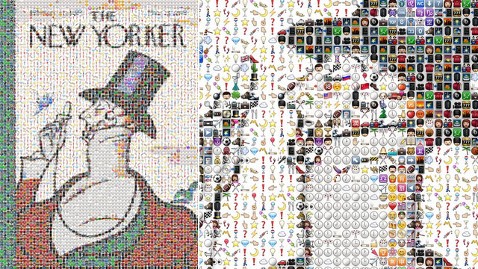The New Yorker's 'Eustace Tilley' Made With iPhone Emoji Icons

Image credit: Mecredis/Flickr
It was the magazine cover the world never saw - until now.
Fred Benenson created this image for The New Yorker in 2009 for a contest inviting new renditions of Eustace Tilley, the foppish character who has appeared annually on the magazine's cover since it began in 1925. Because of a technicality, Benenson never submitted it.
But that was then, and this is now. Three years later, The New Yorker has posted Benenson's " Eustace Emoji" masterpiece along with 14 other submissions for the sixth annual Eustace Tilley contest.
"It's one of many reinterpretations of our already well-known mascot," said Francoise Mouly, Art Editor for The New Yorker. "What distinguishes these images is that they're done by readers which is a wonderful way to get feedback."
Last call for 2013 entries is Jan. 7. After that, Mouly and other editors from The New Yorker will choose 12 winning entries.
"It could go either way. I think this shows people like it [the image] and knowing a little bit about how magazines work - they like exclusive content," said Benenson. "This is the one shot I got."
In 2009 Benenson, a 29-year-old data engineer and photographer, came up with an inventive way to show the famous Tilley profile - he used the Emoji icons found on iPhones. It took him two days to get the details right before he was ready to send it off to the magazine. Then he read the fine print for the contest and realized he wasn't eligible - his girlfriend worked as a writer for The New Yorker.
"We got the vibe that it wasn't going to fly - people knew she worked for The New Yorker - and I didn't want her to be put in that position," said Benenson.
Instead, he posted it on his Flickr account.
How It Was Made
Benenson created the image with Photoshop and a mosaic software program called Foto-Mosaik Edda. In total, there are 4,800 icons used to create his "Eustace Emoji" masterpiece.
"When I had the idea, I thought it was going to be quick," said Benenson. "It's surprisingly difficult to get everything to look right - the software was crashing a lot."
Before his creation for The New Yorker, Benenson had played with Emoji icons for a book, using them to retell Herman Melville's story of Moby Dick. For The New Yorker contest, Benenson said he wanted to push the limits a little more.
"I asked myself what could I do that was weirder and bigger with Emoji," said Benenson. "I was used to working with Emoji as a medium, so I thought maybe I can make an Emoji version of this, and the mosaic idea seemed like the most obvious way to do that."